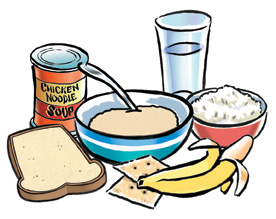Diet for Diarrhea Only (Child)

Diarrhea is a common symptom of illness in children. A child can quickly lose too much fluid and become dehydrated. This is the loss of too much water and minerals from the body. This can be serious and even life-threatening. When this occurs, body fluids must be replaced. This is done by giving your child small amounts of liquids often.
If your child shows signs of dehydration, the healthcare provider may tell you to use an oral rehydration solution. Oral rehydration solution can replace lost minerals called electrolytes. Oral rehydration solution can be used in addition to breast or bottle feedings. Oral rehydration solution may also reduce diarrhea. You can buy oral rehydration solution at grocery stores and pharmacies without a prescription.
In cases of severe dehydration, a child may need to go to a hospital to have IV (intravenous) fluids.
Giving liquids and food
If using oral rehydration solution:
-
Follow your healthcare provider’s instructions when giving the solution to your child.
-
Use only prepared, purchased oral rehydration solution. Don't make your own solution. Sports drinks are not the same as oral rehydration solutions. Sports drinks contain too much sugar and not enough electrolytes for correct dehydration.
-
If diarrhea gets better after 2 to 3 hours, you can stop giving oral rehydration solution.
For solid foods:
-
Follow the diet your child’s provider advises.
-
If desired and tolerated, your child may eat regular food.
-
If unable to eat regular food, your child can drink clear liquids. such as water, or suck on ice cubes. Don’t give high-sugar fluids like juice, sports drinks, or soda. Slowly increase the amount of clear liquids. Alternate these fluids with oral rehydration solution as the provider advises.
-
Don't feed your child high-fat foods.
-
Your child can start a regular diet 12 to 24 hours after diarrhea has stopped. Continue to give plenty of clear liquids.
-
You can resume your child's normal diet over time as they feel better. Don’t force your child to eat, especially if they are having stomach pain or cramping. Don’t feed your child large amounts at a time, even if they are hungry. This can make your child feel worse. You can give your child more food over time if they can tolerate it. Foods you can give include cereal, mashed potatoes, applesauce, mashed bananas, crackers, dry toast, rice, oatmeal, bread, noodles, pretzels, soups with rice or noodles, and cooked vegetables.
-
If the symptoms come back, go back to a simple diet or clear liquids.
Follow-up care
Follow up with your child’s healthcare provider as advised. If a stool sample was taken or cultures were done, call the healthcare provider for the results as instructed.
Call 911
Call 911 if your child has any of these symptoms:
When to get medical advice
Call your child’s healthcare provider or get medical care right away if any of these occur:
-
Abdominal pain that gets worse
-
Constant lower right abdominal pain
-
More than 8 diarrhea stools within 8 hours
-
Continued severe diarrhea for more than 24 hours
-
Blood in vomit or stool
-
Reduced oral intake
-
Dark urine or no urine or dry diapers for 4 to 6 hours in an infant or toddler, or 6 to 8 hours in an older child; no tears when crying, sunken eyes, or dry mouth
-
Fussiness or crying that cannot be soothed
-
New rash
-
Diarrhea lasts more than 10 days
-
Fever (see Children and fever, below)
Fever and children
Use a digital thermometer to check your child’s temperature. Don’t use a mercury thermometer. There are different kinds and uses of digital thermometers. They include:
-
Rectal. For children younger than 3 years, a rectal temperature is the most accurate.
-
Forehead (temporal). This works for children age 3 months and older. If a child under 3 months old has signs of illness, this can be used for a first pass. The healthcare provider may want to confirm with a rectal temperature.
-
Ear (tympanic). Ear temperatures are accurate after 6 months of age, but not before.
-
Armpit (axillary). This is the least reliable but may be used for a first pass to check a child of any age with signs of illness. The provider may want to confirm with a rectal temperature.
-
Mouth (oral). Don’t use a thermometer in your child’s mouth until they are at least 4 years old.
Use the rectal thermometer with care. Follow the product maker’s directions for correct use. Insert it gently. Label it and make sure it’s not used in the mouth. It may pass on germs from the stool. If you don’t feel OK using a rectal thermometer, ask the healthcare provider what type to use instead. When you talk with any healthcare provider about your child’s fever, tell them which type you used.
Below are guidelines to know if your young child has a fever. Your child’s healthcare provider may give you different numbers for your child. Follow your provider’s specific instructions.
Fever readings for a baby under 3 months old:
Fever readings for a child age 3 months to 36 months (3 years):
-
Rectal, forehead, or ear: 102°F (38.9°C) or higher
-
Armpit: 101°F (38.3°C) or higher
Call the healthcare provider in these cases:
-
Repeated temperature of 104°F (40°C) or higher in a child of any age
-
Fever of 100.4° (38°C) or higher in baby younger than 3 months
-
Fever that lasts more than 24 hours in a child under age 2
-
Fever that lasts for 3 days in a child age 2 or older